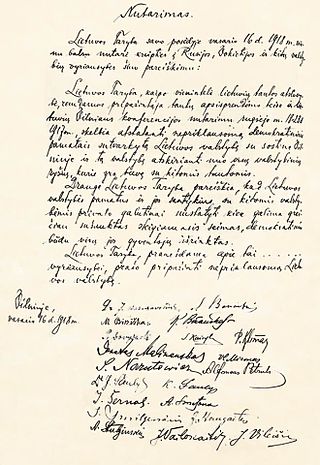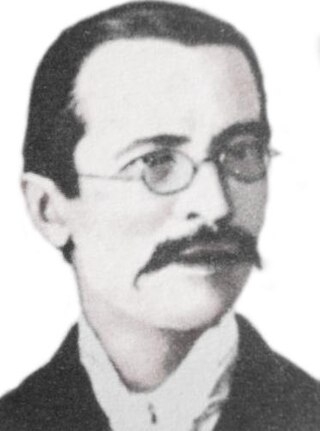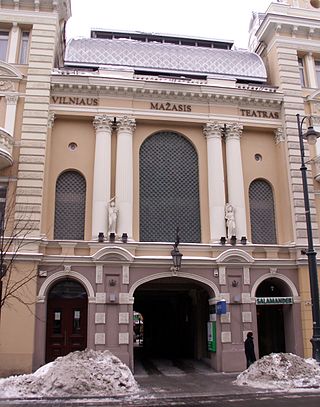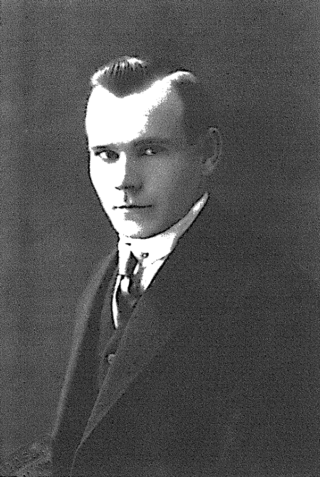Related Research Articles

"Tautiška giesmė" is the national anthem of Lithuania, also known by its opening words, "Lietuva, Tėvyne mūsų", and as "Lietuvos himnas". The music and lyrics were written in 1898 by Vincas Kudirka, when Lithuania was still part of the Russian Empire. The fifty-word poem was a condensation of Kudirka's conceptions of the Lithuanian state, the Lithuanian people, and their past. Shortly before his death in 1899, the anthem was performed for Lithuanians living in Saint Petersburg, Russia.
Ypatingasis būrys or Special SD and German Security Police Squad (Lithuanian: Vokiečių Saugumo policijos ir SD ypatingasis būrys, Polish: Specjalny Oddział SD i Niemieckiej Policji Bezpieczeństwa, also colloquially strzelcy ponarscy was a Lithuanian, killing squad also known as the "Lithuanian, equivalent of Sonderkommando", operating in the Vilnius Region. The unit, primarily composed of Lithuanian volunteers, was formed by the German occupational government and was subordinate to Einsatzkommando 9 and later to Sicherheitsdienst and Sicherheitspolizei. The unit was subordinated to German police, and had no official autonomy.

Užgavėnės[ʊʒ'ɡaːvʲeːnʲeːs] is a Lithuanian festival that takes place during the seventh week before Easter. Its name means "the time before Lent". The celebration corresponds to Roman Catholic holiday traditions in other parts of the world, such as Mardi Gras, Shrove Tuesday, and Carnaval.

The Act of Independence of Lithuania or the Act of February 16, also the Lithuanian Resolution on Independence, was signed by the Council of Lithuania on February 16, 1918, proclaiming the restoration of an independent State of Lithuania, governed by democratic principles, with Vilnius as its capital. The Act was signed by all twenty representatives of the Council, which was chaired by Jonas Basanavičius. The Act of February 16 was the result of a series of resolutions on the issue, including one issued by the Vilnius Conference and the Act of January 8. The path to the Act was long and complex because the German Empire exerted pressure on the Council to form an alliance. The Council had to carefully maneuver between the Germans, whose troops were present in Lithuania, and the demands of the Lithuanian people.

Juozas Adomaitis known by his pen name Šernas (1859–1922) was a Lithuanian non-fiction writer. He contributed to the Lithuanian-language newspapers Aušra and briefly served as editor of Varpas. In 1895, he moved to the United States where he worked as editor of the Lithuanian weekly Lietuva. He published about 20 popular science books about biology, ethnology, geography, history of writing.

Gabrielė Petkevičaitė was a Lithuanian educator, writer, and activist. Her pen name Bitė (Bee) eventually became part of her last name. Encouraged by Povilas Višinskis, she joined public life and started her writing career in 1890, becoming a prominent member of the Lithuanian National Revival. She was the founder and chair of the Žiburėlis society to provide financial aid to struggling students, one of the editors of the newspaper Lietuvos žinios, and an active member of the women's movement. In 1920, she was elected to the Constituent Assembly of Lithuania and chaired its first session. Her realist writing centered on exploring the negative impact of the social inequality. Her largest work, two-part novel Ad astra (1933), depicts the rising Lithuanian National Revival. Together with Žemaitė, she co-wrote several plays. Her diary, kept during World War I, was published in 1925–1931 and 2008–2011.
Saulius Šaltenis is a Lithuanian writer, newspaper editor, and politician. In 1990, he was among those who signed the Act of the Re-Establishment of the State of Lithuania. He served as the Minister of Culture from 1996 to 1999 in the Government of Gediminas Vagnorius

Rūta Society was a Lithuanian cultural society in Vilnius, then part of the Russian Empire, active from 1909 to the outbreak of World War I in 1914. It organized various events, including lectures, literary evenings, and musical performances, but it is most noted for its contribution to the development of the Lithuanian theater. In total, Rūta staged about 50 plays.

The Birutė Society was the first cultural non-religious society of Prussian Lithuanians. Established in 1885 in Tilsit, East Prussia, the society was intermittently active until the outbreak of World War I. The society sought to preserve Lithuanian language and culture and protect them form Germanization. While it discussed linguistic and cultural subjects, the society never raised issues of social inequality or protested against the political regime of Kaiser Wilhelm II. The society prompted the division of Prussian Lithuanians into two main groups: religious conservative versus secular liberals. Birutė is best remembered for organizing festivals and celebrations that featured Lithuanian-language performances of various folk and patriotic songs as well as amateur theater performances, including the first Lithuanian-language theater performance in 1895.
The Lithuanian National Cemetery is a non-profit cemetery in Justice, Illinois, that mainly serves the Lithuanian American community in Chicago. Established in 1911, it is the resting place of many prominent Lithuanians in politics, culture, and science.
America in the Bathhouse is a three-act comedy by Keturakis. The play was first published in 1895. It became the first Lithuanian-language play performed in public in present-day Lithuania when a group of Lithuanian activists staged it on 20 August 1899 in Palanga. The play depicts an episode from the everyday life of the Lithuanian village – a resourceful man swindles money from a naive woman and escapes to the United States. Due to its relevant plot, small cast, and simple decorations, the play was very popular with the Lithuanian amateur theater. It became one of the most popular and successful Lithuanian comedies of all time and continues to be performed by various troupes.

The Lithuanian Art Society was a society that organized Lithuanian art exhibitions and supported Lithuanian artists. Based in Vilnius, it was active from 1907 to the outbreak of World War I in 1914. It was chaired by painter Antanas Žmuidzinavičius. The society was established after the first Lithuanian art exhibition was successfully organized in early 1907. The society continued to organize annual exhibitions that displayed works both by professional and folk artists. Influenced by the Arts and Crafts movement, the society paid great attention to Lithuanian folk art which was increasingly seen as an expression of the Lithuanian character. In 1912, the society published an album of drawings of Lithuanian crosses, column shrines, and roofed poles, which is considered the first study of Lithuanian folk art. The society was also instrumental in preserving the art of Mikalojus Konstantinas Čiurlionis and organized his first solo exhibitions in 1911 and 1913. The society also collected works by other artists and worked with the Lithuanian Scientific Society to establish a Lithuanian art museum. The collection was transferred to the present-day M. K. Čiurlionis National Art Museum in 1920.
Juozapas Ambraziejus or Ambrozevičius (1855–1915) was a Roman Catholic priest active in Lithuanian culture life in Vilnius in 1896–1908.

Jonas Kriaučiūnas was a Lithuanian activist during the Lithuanian National Revival mostly noted for editing and publishing Lithuanian periodicals Varpas and Ūkininkas in 1891–1895 and Vilniaus žinios in 1905–1906.
The Lithuanian and Samogitian Charitable Society was a charitable society active in Saint Petersburg in 1892–1918. For a time, it was only legal Lithuanian organization in the Russian Empire. It provided financial support to Lithuanian students and maintained a Lithuanian school attached to the Church of St. Catherine. It also organized Lithuanian cultural evenings with amateur theater performances, dances, songs. In 1895, it staged the first public Lithuanian play in the Russian Empire.
Schutzmannschaft Battalion 259 was a Lithuanian auxiliary police battalion formed in April 1944 in Prienai. It was soon disbanded in July of that same year in Tilsit. The battalion was formed from the soldiers sent by the Training Unit and the 3rd Lithuanian Construction Battalion. The 259th Battalion was the last Lithuanian Police Battalion to be formed.

Petras Būtėnas was a Lithuanian linguist and public figure. His work was very important in the research of Lithuanian culture.

The Lithuanian Sanitary Aid Society was a Lithuanian society established in 1918 to provide medical care to refugees during World War I. First established in Minsk, the society purchased hospital equipment of a war hospital and relocated to Vilnius in July 1918. There it opened a hospital and continued to operate it until around 1941. Over the years, the hospital treated a total of about 300,000 patients. It was a charitable society, thus many of its treatments were provided at low cost or for free. After Vilnius incorporation into the Second Polish Republic, the society and the hospital were one of a few Lithuanian institutions active in Vilnius Region. The society and the hospital were headed by Danielius Alseika and, after his death, by Vytautas Legeika.
Rokiškis Music School was a music school sponsored by the Tyzenhaus family that operated in Rokiškis from 1873 to 1904. While it focused on preparing church organists, several prominent Lithuanian interwar musicians were its alumni.

Birutė is a two-act opera composed by Mikas Petrauskas based on the play by Gabrielius Landsbergis-Žemkalnis. It was first performed on 6 November 1906 in Vilnius and became the first Lithuanian national opera. The plot is based on the medieval legend about the love between Birutė and Grand Duke of Lithuania Kęstutis recorded in the Bychowiec Chronicle and in the chronicle of Maciej Stryjkowski. The opera was written for the amateur Lithuanian performers and thus is mostly valued for its historical significance.
References
- 1 2 3 Juozas Kudirka, Visuotinė lietuvių enciklopedija (Universal Lithuanian Encyclopedia)
- 1 2 3 Daiva Venclovienė, "Juozo Kudirkos gyvenimas ir kūryba (1939 03 19 – 2007 06 21)", Gyvenimas, May 21, 2019
- ↑ „100 iškiliausių Prienų krašto asmenybių“ – Juozas Kudirka ("100 most prominent personalities of the Prienai District" - Juozas Kudirka) , information from the Prienai District Museum
- 1 2 3 Žilvytis Šaknys, "Juozas Kudirka", an obituary in Lietuvos Etnologija, July 2007
- 1 2 Rasa Paukštytė - Šakniene, Etnografinių tyrimų laukas už Lietuvos ribų: šeima ir jos papročiai, LITHUANISTICS, 2019. Vol. 65. No. 2(116), p. 124–139
- ↑ "1999 m. Nacionalinių kultūros ir meno bei J.Basanavičiaus premijos įteikimo ceremonija"
- ↑ Aldona Kačerauskienė, "Jono Basanavičiaus premija ir jos laureatai", Amžius, December 10, 2008